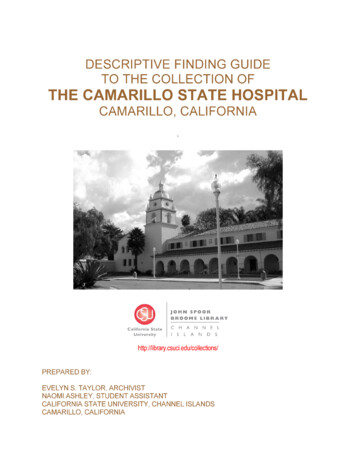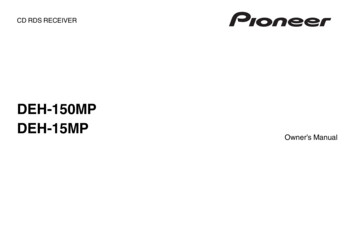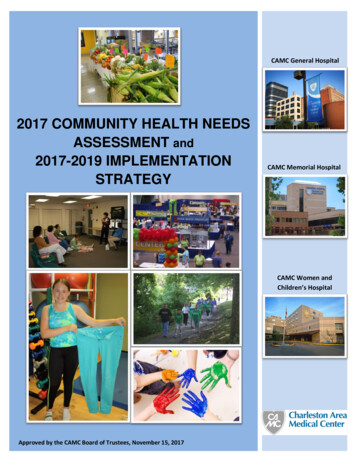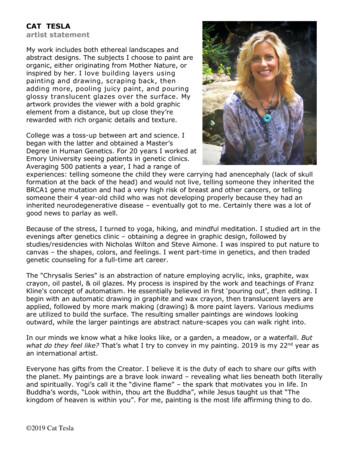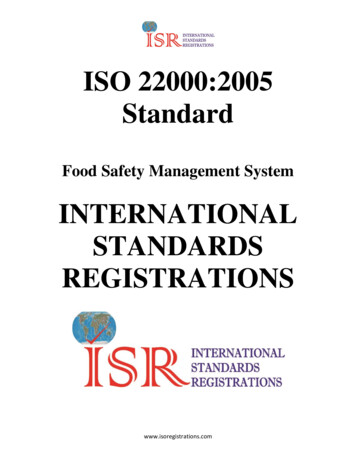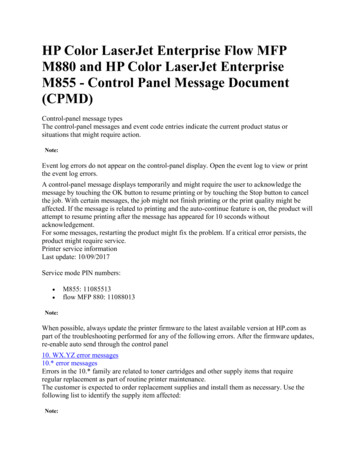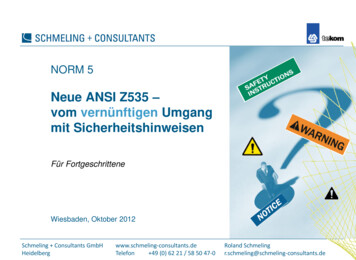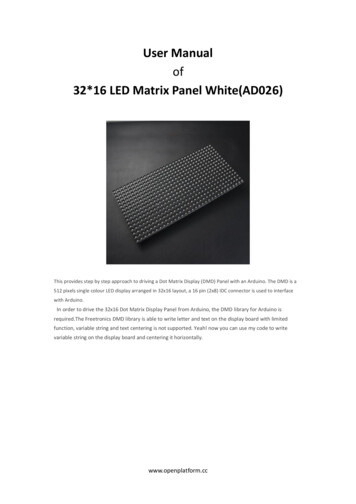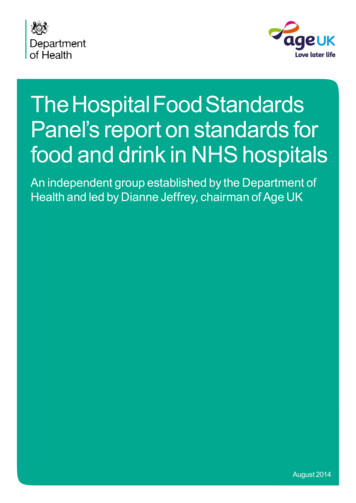
Transcription
The Hospital Food StandardsPanel’s report on standards forfood and drink in NHS hospitalsAn independent group established by the Department ofHealth and led by Dianne Jeffrey, chairman of Age UKAugust 2014
DH ID boxTitle: The Hospital Food Standards Panel’s report on standards for food anddrink in NHS hospitalsAuthor: Directorate/ Division/ Branch acronym / cost centreIGO/NHSEFP/29170Document Purpose:Policy GuidancePublication date:August 2014Target audience: Chairs and Chief Executives of NHS organisations, Directorsof Estates, Medical directors, Directors of Nursing, Facilities Directors, cateringmanagers, dietitiansContact details:Liz Jones, Head of Patient Environment.elizabeth.jones@dh.gsi.gov.uk Crown copyright 2014
The Hospital Food StandardsPanel’s report on standards forfood and drink in NHS hospitalsAn independent group established by the Department ofHealth and led by Dianne Jeffrey, chairman of Age UK
2 The Hospital Food Standards Panel's report on standards for food and drink in NHS hospitals
Contents iiiContentsForeword1Summary of recommendations3Introduction5The recommendations7Patient nutrition and hydration11Healthier eating across hospitals17Sustainable food and catering services21Conclusions25Annex A Required standards definitions27Annex B Terms of Reference31Annex C Supporting documents33Acknowledgements35
4 The Hospital Food Standards Panel's report on standards for food and drink in NHS hospitals
Foreword 1ForewordEvery hospital has a responsibility to provide the highest level of care possible for theirpatients and this, without question, includes the quality and nutritional value of the food that isserved and eaten.It is important that the quality of food served to your patients is nutritious. Many hospitalsdo provide high quality food and drink, but the variation across the country is too great. TheHospital Food Panel was set up by Dr Dan Poulter, Parliamentary Under Secretary for Health,to tackle this problem by examining existing food standards, advising on how they should beapplied and monitored, and recommending future improvement actions.As a chief executive you are ultimately responsible for ensuring that patients have a positiveexperience during their stay, including when it comes to their nutrition. This report will provideyou and your team with the guidance and tools to help achieve this.After looking at over 50 potential standards, the Panel has identified the five key ones to makethe biggest difference to patients, staff and visitors.As an indication of how serious the Government takes nutrition and hospital food, we areintroducing these as legally binding standards in the NHS Standard Contract.We are grateful to the panel members and to the supporting Expert Reference Groups fortheir tireless dedication to improving hospital food and for their generosity in sharing theirknowledge.We trust that the NHS will find this report supportive and patients will reap the benefits acrossthe country.Jeremy HuntSecretary of State for HealthState for HealthDianne JeffreyChairman, Age UK
6 The Hospital Food Standards Panel's report on standards for food and drink in NHS hospitals
Summary of recommendations 3Summary of recommendationsThe Panel recommends that all NHS hospitals should develop and maintain a food anddrink strategy. This should include: the nutrition and hydration needs of patients healthier eating for the whole hospital community, especially staff sustainable procurement of food and catering servicesThe Panel recommends that the following standards become required practice acrossNHS hospitals:Five required hospital food standards The 10 key characteristics of good nutrition and hydration care from the NHS EnglandClick here Nutrition and Hydration Digest (The British Dietetic Association) Click here Malnutrition Universal Screening Tool (British Association of Parenteral and EnteralNutrition) or equivalent validated nutrition screening tool Click here (For staff and visitor catering) Healthier and More Sustainable Catering – NutritionPrinciples ( Public Health England ) Click here Government Buying Standards for Food and Catering Services from the Departmentof Environment, Food and Rural Affairs Click hereThe Panel recognises that there are other tools and assurance schemes that can be ofuse in promoting excellence. It is for hospitals to decide for themselves where these toolsor approaches work for them.The Panel recommends that work should continue with the likes of NHS England andDefra, to make sure that the importance of hospital food is recognised for its contributionto the well-being of individuals and communities and for the benefits this will bring tosociety, through increased productivity and decreased healthcare costs.The Panel recommends that required standards should be monitored via annual Patient led Assessments of the Care Environment (PLACE) and that PLACE should be amendedto include a more detailed evaluation of the taste, flavour and presentation of hospital food.
8 The Hospital Food Standards Panel's report on standards for food and drink in NHS hospitals
Introduction 5IntroductionOur diet significantly affects our health. This is true for both overnutrition (which can lead toobesity) and undernutrition.Malnourished patients in hospital stay longer and are more likely to develop complications orinfections. At home, they visit their GPs more often. Most malnutrition arises in the community,but once a patient is admitted, there is a great deal that hospitals can do to hasten recoverywith close attention to nutrition and hydration needs.For most inpatients, nutritional care will be based on the food provided by the hospital.Some patients with severe malnutrition will need nutritional supplements and there is goodevidence that they can reduce complications and speed recovery. But nutritional supplementscan often be avoided if the hospital can provide the right food to meet patients’ needs forrecovery, wound healing and rehabilitation. This can have significant cost savings, as well asdelivering a far better experience.At the same time, some patients will be dealing with illness brought on by overconsumption.In England, many people are overweight or obese. This includes almost 62% of adults and28% of children aged between 2 and 15. People who are overweight have a higher risk ofgetting type 2 diabetes, heart disease and certain cancers. Excess weight can also makeit more difficult for people to find and keep work, and it can affect self-esteem and mentalhealth. Health problems associated with being overweight or obese cost the NHS more than 5 billion every year.Obesity and overweight also affect NHS staff. Over half of all the food provided in NHShospitals is served to staff and visitors, and their needs are very different from those ofpatients. Hospitals have a role as beacons of good practice in supporting staff to makehealthier choices. This is particularly the case for shift workers and those eating at unsocialhours, who may easily fall victim to poor eating habits if choice is restricted.Hospitals also have a wider social responsibility. As major purchasers and providers of foodand catering services, they have the opportunity to put sustainability at the heart of their work.This might include reducing waste, embedding high standards of farm and food productionthat reflect UK standards of production, reducing their carbon footprint and making theircatering contracts accessible to small business. This has the indirect benefit of supporting UKbusinesses which already meet or are working towards meeting these high standards.Hospital food should meet all these challenges. It should complement the patient’s care andenhance their stay. It should help staff and visitors choose a healthier lifestyle and it shouldsupport our economy and protect our environment. Hospital food can – and should – be avehicle for improvement and a role model for food in the local community. Crucially, it shouldalso be a source of pleasure and enjoyment.
6 The Hospital Food Standards Panel’s report on standards for food and drink in NHS hospitalsMany hospitals provide food and drink that demonstrates these ideals in action. But somestruggle to deliver on one or more aspects, and variation across the country is too great. TheNHS has a full array of catering services from on-site cooking to bought-in/delivered mealsand from NHS-employed staff to contract caterers. All are capable of delivering excellent food.Equally, all can fail if they are not implemented properly.The Hospital Food Standards Panel was set up to tackle this by examining existing foodstandards, advising on how they should be applied and monitored, and recommendingfurther actions to maintain improvement in the future. Their terms of reference are in Annex B.The Panel did not set out to produce new standards. To do so would have been to add tothe already substantial burden of standards and potentially to obscure, rather than clarifywhat is expected. Rather, they identified potentially relevant standards and assessed them fortheir applicability to hospital food and catering services in England. Bringing a small numberof highly relevant standards together in this way should make it easier for all involved tocommission, provide and monitor food service.Assessing the standards was a major undertaking. To speed the process and to harness awide range of expertise, the panel established three Expert Reference Groups (ERGs), eachtaking on a particular aspect of hospital food and drink. They met separately to assess therelevant standards and the tools that can be used to ensure proper implementation. Theyreported (via their Chairs) to the main panel. The final recommendations were made by themain panel.The Panel has identified a number of ‘required standards’ that should become routinepractice in all hospitals.The aim is to improve food and drink across the NHS, so that everyone who eats therehas a healthier food experience*, and so that everyone involved in its production isproperly valued.The Panel has also made more general recommendations about how food and drinkmight be improved. These particularly concern the importance of continued action onfood and drink, with an emphasis on flavour, taste and presentation.*By a healthier food experience we mean that patients, staff and visitors are offered a selection of foodand drink that meets their daily nutritional needs and reduces the risk of later ill-health. For most peoplethis would equate to the ‘eatwell plate’. Some people may need more energy rich food and drink andothers less. All need to ‘eat for good health’.
The recommendations 7The recommendationsThe Panel recommends that NHS hospitals develop and maintain a food and drinkstrategy.This should capture how the organisation will address nutritional care for patients,deliver healthier food for the whole hospital community (particularly staff), and embedsustainability into its service. It should also pay close attention to the end-quality of foodand drink served, so that everyone receives meals they can enjoy.The Panel notes relevant standards that already apply across the NHS. These includestatutory standards such as CQC registration standards, NICE Quality standards(which NHS England must have regard to), and NICE Clinical Guidelines. Nothing in thisreport countermands or supersedes these and they should form part of any strategy.The Panel also flags up the Government Buying Standard for Food & Catering andthe Balanced Scorecard developed by Defra as relevant to the development of thesestrategies.The Panel recommends five food standards that should be required for all hospitals,whatever their patient population or catering method. ‘Required’ standards arethose that should become routine practice across the NHS. The Panel suggeststhat they should be referenced in the NHS Standard Contract, so thatcommissioners of care can be clear about what they expect of hospital food and canhold providers to account if they do not measure up.Required standardsFor patient catering 10 key characteristics of good nutrition care and hydration, NHS England Nutrition and Hydration Digest, The British Dietetic Association Malnutrition Universal Screening Tool or equivalent1 (BAPEN)For staff and visitor catering (and applied as appropriate to patient catering)2 Healthier and More Sustainable Catering – Nutrition Principles (Public Health England)For all catering Government Buying Standards for Food and Catering Services, HMG standardsdeveloped by the Department of Environment, Food and Rural Affairs1‘equivalent’ means a validated screening tool appropriate to the patient population. Where appropriate,and subject to prior local agreement, specific groups of patients may be excluded from routine screening.The specific nutritional needs of individual patients should always supersede the application of blanketprinciples.2
8 The Hospital Food Standards Panel’s report on standards for food and drink in NHS hospitalsWhat is the NHS Standard Contract?The NHS Standard Contract is used by commissioners of healthcare - clinicalcommissioning groups or NHS England – to purchase healthcare from healthcareproviders such as NHS Trusts, NHS Foundation Trusts and providers from theindependent and voluntary sectors. It is specified by NHS England for use whencommissioning all healthcare services other than primary care.Inclusion of new standards on hospital food within the NHS Standard Contract meansthat the provider organisations are obliged, under the terms of their legally-bindingcontracts with commissioners, to adhere to the requirements which the standardsset out. Commissioners will be able to require information from providers about theircompliance with the standards. Providers which do not comply would be in breach oftheir contract, and commissioners would be able to take contractual action against them.Such action would typically involve agreement and implementation by the provider of aremedial action plan, through which the provider would put right the breach and ensurefull compliance with the standards for the future. If a material breach of the standardspersisted or was repeated, however, the commissioner would have the ability, under theNHS Standard Contract, to report the breach formally to the provider’s Board and to levysignificant financial sanctions.Recognised tools and schemesIn addition to the required standards, there are other tools and assurance schemes thatcan support improvement and reward excellence in some cases. ‘Recognised’ tools andschemes are not compulsory and will not feature in the Standard Contract, but they can be ofuse in promoting excellence. Some may be useful in negotiating CQUIN agreements. It is forhospitals to decide for themselves whether these approaches work for them. They include: The Plan for Public Procurement of Food and Catering Services – Balanced Scorecard.Click here The relevant Responsibility Deal Pledges Out of Home Calorie labelling (pledge F1) Click here Calorie Reduction (Pledge F4) Click here Salt reduction including 2017 targets (pledges F5,F9, and F10) Click here or Click here Health at Work (pledge H4) Click here The Soil Association’s Food for Life Catering Mark assurance scheme3 Click here3The Food for Life Catering Mark is not the only relevant scheme, but it takes on board other schemes suchas Red Tractor, and is the most relevant to catering services. It includes criteria that go beyond those in therecommended standards
The recommendations 9The Panel recommends that work should continue with the likes of NHS England andDefra, so that the importance of hospital food is recognised for its contribution to thewell-being of individuals and communities and for the benefits this brings to society,through increased productivity and lower healthcare costs.Legacy work has already been planned and indeed, some is already under way. ThePanel was keen to build on the partnerships established during their work and manymembers have already committed to taking work forward.The Panel recommends that required standards should be monitored via annualPatient-led Assessments of the Care Environment (PLACE) and that PLACE should beamended to include a more detailed evaluation of the taste, flavour and presentation ofhospital food.Work has already begun with NHS England, the Health and Social Care InformationCentre and the Department of Health to put these plans into action. Questions will beincluded that measure how well hospitals are working towards required standards.The revised PLACE assessment will also generate information that patients can use tohelp them judge the quality of the food at their local hospital. This will include a clearemphasis on taste, texture and temperature, recognising how important this is to overallpatient experience.ResourcesThere is also a useful list of supporting documents which can be used as a resource tosupport organisations in meeting their food and drink policies. This is in Annex C.
10 The Hospital Food Standards Panel's report on standards for food and drink in NHS hospitals
Patient nutrition and hydration 11Patient nutrition and hydrationChair: Marie Batey, NHS England‘The very best nutritional care, delivered with clinical expertise, compassion and humanity,is pivotal to enabling people to stay healthy and to recover from episodes of illness. Centralto this is assessing patients’ needs; meeting these needs; regularly evaluating plans ofcare and creating the optimum environment where the best possible practice can occur.Leadership and direction at all levels and a clear and demonstrable set of values (suchas the 6Cs of Compassion in Practice) underpinning a culture of compassionate care andplacing the people we care for at the heart of everything, makes a huge difference topatients, carers and to staff.The Nutritional Care Expert Reference Group was mindful of this and has sought to bringclarity to the optimum ways of delivering high quality nutritional care.’The Patient Nutrition and Hydration ERG focused their attention on standards relating tothe food and meal service for patients. This included standards aimed at establishing goodpractice, improving nutritional content of meals and identifying (and solving) clinical nutritionalproblems. The ERG did not cover specialist or high-tech nutritional intervention beyond theprovision of food and drink, but they noted the CQC registration standards and NICE QualityStandards and Clinical Guidelines, which the NHS is already required to take account of.The ERG recognised the very wide range of health and nutritional needs that must be met.The standards they recommend reflect three main areas: creating the right overall environment for good nutrition and hydration delivering the right nutritional content within the menu making sure that patients’ needs are properly identified and metThe group noted that the phrase ‘healthy eating’ can bring to mind a diet that is restrictedin calories, and wanted to be clear that hospital food must support the health of all patients.Some dietitians and catering staff use the term ‘eating for health’ to draw out this distinctionand the panel agreed that this might be helpful. ‘Healthy eating’ refers to the everyday dietthat would benefit most people, whilst ‘eating for health’ describes a therapeutic diet that istailored to the individual.The recommended standards meet the requirements of patients who are at risk ofmalnutrition and need additional calories within a small portion size. This includesmalnourished patients, those with eating disorders or patients undergoing chemotherapy.These patients can make up as much as one third of hospital admissions. The standards alsoserve those who are seeking to reduce calorie intake to manage obesity or related disorders.Patients are more likely to make changes to their diet after experiencing an acute admission,so the hospital should do all it can to help them.
12 The Hospital Food Standards Panel’s report on standards for food and drink in NHS hospitalsEating for Health and Healthy EatingThe NHS has a responsibility to promote good health, and the food it serves is a part ofthat. But what is ‘healthier food’? For some, it might be fresh fruit and salads, but for thefrail and underweight, it may well be a high calorie, nutritionally dense snack. The bestfood services can meet both those needs – whilst delivering great flavour for everyone.For patients, we are concerned about ‘eating for health’ whilst for staff and visitors it isimportant that we set an example of how to support tasty and satisfying ‘healthier eating’.Malnutrition is easily missed. To be sure that all patients get the nutritional care they need,they should be screened on admission and regularly during their stay. If necessary, a personalnutritional care plan should be implemented. Screening should follow a validated process(such as the Malnutrition Universal Screening Tool (MUST)) so that actions are properlyidentified and carried out. Crucially, this means that the right food is provided and that patientsget all the help they need to eat and drink.The Panel agreed the following required standards for optimal patient nutrition and hydration.Ten key characteristics of good nutrition and hydration care (NHS England)The ‘Ten Key Characteristics’ standard was developed in 2003 from a Council of Europereport. It offered an overarching set of principles that were of particular help in developinga patient-focused food and drink strategy. They were reviewed in 2015 by NHS England. Theupdated key characteristics are:1. Screen all patients and service-users to identify malnourishment or risk ofmalnourishment and ensure actions are progressed and monitored.2. Together with each patient or service user, create a personal care/support planenabling them to have choice and control over their own nutritional care and fluidneeds.3. Care providers should include specific guidance on food and beverage services andother nutritional & hydration care in their service delivery and accountabilityarrangements.4. People using care services are involved in the planning and monitoring arrangementsfor food service and drinks provision.5. Food and drinks should be provided alone or with assistance in an environmentconducive to patients being able to consume their food (Protected Mealtimes).6. All health care professionals and volunteers receive regular raining to ensure theyhave the skills, qualifications and competencies needed to meet the nutritional andfluid requirements of people using their services.7. Facilities and services providing nutrition and hydration are designed to be flexibleand centred on the needs of the people using them, 24 hours a day, every day.8. All care providers to have nutrition and hydration policy centred on the needs of users,and is performance managed in line with local governance, national standards andregulatory frameworks.9. Food, drinks and other nutritional care are delivered safely.10. Care providers should take a multi-disciplinary approach to nutrition and hydrationalcare, valuing the contribution of all staff, people using the service, carers andvolunteers working in partnership
Patient nutrition and hydration 13For further information hyd/10-key-characteristics/
14 The Hospital Food Standards Panel’s report on standards for food and drink in NHS hospitalsCase StudyRoyal Liverpool University Hospital and the 10 Key CharacteristicsRoyal Liverpool University Hospital recognised that not every group of patients canbe accommodated by routine meals times. Working with patients, they devised a callorder service so that patients who were unable to eat at mealtimes could get food whenthey felt like it. The key to their success was the engagement of all disciplines and theinvolvement of patients. Patients responded positively and were much happier. Nursingstaff reported improved patient satisfaction. The hospital applies different offers fordifferent patient groups, with trials in gerontology and surgical wards.RLH’s Patient Meal Experience GroupCase StudyStoke Mandeville HospitalEvery month, staff at Stoke MandevilleHospital are offered the opportunity to tastethe patient food and rate it. This has beenextremely successful and has resulted infood that has not been considered “up tostandard” being removed immediately. Thehospital looks at patient surveys, and whatthe trends are in menu ordering – if a mealis unpopular they try to find out why, and ifnecessary replace it with a more palatableone. The staff try all types of food offered – including texture-modified and othertherapeutic diets. It is an excellent way of ensuring quality control. They plan to invitepatient representatives to come in and taste the food as well.
Patient nutrition and hydration 15Nutrition and Hydration Digest (British Dietetic Association)The BDA Digest is a detailed toolkit that covers a wide audience, including hospital patients,people in care settings, recipients of community care and those in their own homes. Usingthe Digest will help hospitals to deliver meals of appropriate nutritional content, tailored toindividual needs.The Digest contains sections on the role of the dietitian in food service, nutritional analysis andhow to ensure optimal consumption. It introduces the ‘day parts’ approach and covers menudesign, content and capacity, cultural and therapeutic diets, dietary coding guidance, cateringspecifications and food service systems. It also provides an evidence document for contracttenders and specifications.For further information itionHydrationDigest.pdfCase StudyLeeds Teaching Hospitals NHS Trust and the BDA DigestAt Leeds Teaching Hospitals NHS Trust areview of the patient menu on the OlderAdult wards has led to smaller portionsof nutritious items (providing a minimumnutritional content) at lunchtime alongwith easier to eat/finger food items.This has been supplemented with anafternoon tea service, providing eachward with a locally baked fresh cake(on a covered cake stand) to be servedwith afternoon tea. The cakes andportion sizes have been chosen so thatAfternoon tea with the Chief Nurse at Leedsthey provide a higher energy snack, asdefined in the Nutrition and HydrationDigest. Posters of the afternoon tea andthe menus are available on the wards topromote this service.
16 The Hospital Food Standards Panel’s report on standards for food and drink in NHS hospitalsMalnutrition Universal Screening Tool, or equivalentScreening patients is essential to identify those patients who need specific dietary support.The ERG specified the MUST tool because of its wide applicability, but recognised that othertools are available and can be more appropriate for specific groups (eg children).The Malnutrition Universal Screening Tool (MUST) is a validated instrument developed by theBritish Association for Parenteral and Enteral Nutrition (BAPEN) and is the most commonlyused tool throughout the UK. It is a simple five-step method designed to identify adults at riskof malnutrition and to categorise them as being at low, medium or high risk. It can be used byall health and care workers in all care settings. It is recommended by a number of professionalbodies including the RCN, the BDA and NICE.For more information visithttp://www.bapen.org.uk/pdfs/must/must full.pdfCase StudyPoole Hospital NHS Foundation Trust and MUSTDebbie Thompson, Nutrition NurseSpecialist, was appointed in May 2011and tasked with improving the Trust’sMUST nutrition screening. An initial auditin June 2011 found poor compliance(24% of patients screened with 24hours of admission), but a consistentand tireless approach has meant thelatest audit showed a considerableimprovement with 96% of patients nowMUST screened (90% within 24 hours ofadmission)Going forwardThe Patient Nutrition and Hydration ERG identified a number of topics that warrant furtherwork. These included: Review and possible refresh of the 10 Key Characteristics of Good Nutritional Care. Further consideration of the Protected Mealtimes concept. An exploration of the problems caused for patients by food packaging,( such as milkjiggers, butter pats and so on) Further work to describe and deliver excellence in texture-modified foods. Attention to nutritional care learning needs across the healthcare system.
Patient nutrition and hydration 17The group suggested that a Nutrition and Hydration Strategy Group should be establishedwithin NHS England to take this work forward. This has been agreed and the group isexpected to commence its work later this year.
Healthy eating across hospitals 17Healthier eating across hospitalsSusan Jebb, University of Oxford‘Dietary habits underpin the current rising obesity rates and associated chronic diseases.Hospitals and other organisations need to support individuals in making healthier choicesby the provision of healthier, tasty, affordable and sustainable options. The food and drinkthat is available in hospitals should complement the public health message from theNHS.’The Healthier Eating ERG focused on the food available to staff and visitors. This includedstaff canteens and the wider hospital environment such as on-site shops and vendingmachines. They recognised that many patients would also use these facilities, but in the main,inpatient food was identified as the responsibility of the Nutritional Care Expert ReferenceGroup.The whole-organisation strategy for food and drink was particularly important to this group.Staff need healthier and nutritious food to support them in delivering optimal clinical care, andboth staff and visitors need food services that encourage them to make healthier choices.The group was unanimous in their agreement about the public he
Our diet significantly affects our health. This is true for both overnutrition (which can lead to obesity) and undernutrition. . getting type 2 diabetes, heart disease and certain cancers. Excess weight can also make . it more difficult for people to fin

